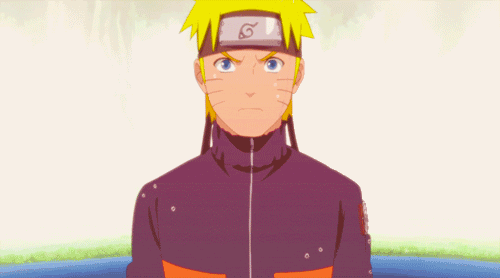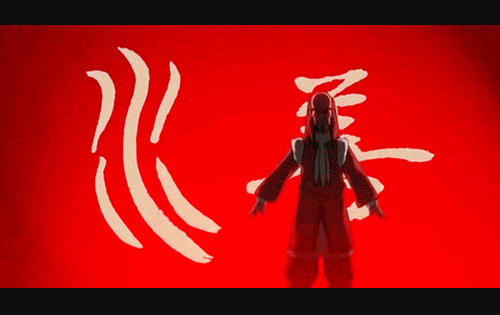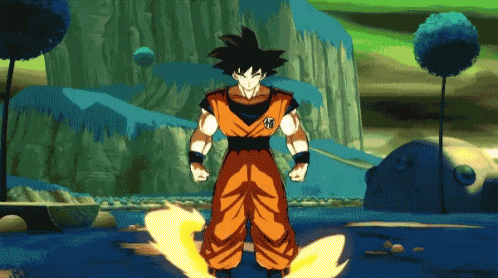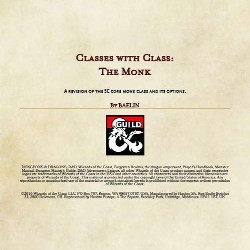As detailed in a previous review, D&D 5E’s monk class is broken, consistently underperforming compared to other martial classes in the game.
Baelin’s Revised Monk is another PDF product that attempts to fix this. Whereas DarkAbyssKeeper’s Revised Monk focuses on a complete overhaul of the class’s core mechanics, Baelin’s version just tweaks the core, instead focusing on improving the primary monk archetypes to bring them more in line with the expected vision of an Eastern-style martial artist.
How Baelin’s Revised Monk Differs from the RAW Monk Class
Changes to Core Monk Class
Baelin modifies four of the RAW (Rules as Written) monk abilities:
- Unarmored Defense gains the Iron Body variant, which improves armor class for strength-based monks.
- Stunning Strike gets nerfed, limiting the power to once per turn.
- Empty Body removes the spell-like effects of invisibility and astral projection (along with the hefty ki cost) and instead fulfills the Crouching Tiger, Hidden Dragon wuxia-fueled fantasy of gravity-defying unfettered combat movement.
- Perfect Self in RAW is the worst capstone ability of any class. Baelin’s rewrite greatly improves this by reinserting the damage resistances (sans ki cost) and astral projection abilities that previously resided in the Empty Body feature. Astral projection also gains the option to bring other characters along for the ride.
Changes to Monk Archetypes
Way of the Open Hand
Wholeness of Body no longer requires a long rest:
- Pro: It now uses Hit Dice to fuel it (although it does much less healing in one shot) and can also affect other living creatures — a great feature and it incorporates a little-used resource. You are trading single-shot HP for increased frequency and PC support.
- Con: It still takes an action. At higher levels this will almost always be a waste of an action since the healing-per-use is so limited. Changing this to a bonus action (cf. Moon Druid’s Combat Wild Shape healing) would make this power worthwhile.
Tranquility adds the option to extend a calming aura around the monk. It’s a nice touch that enhances the peaceful themes of this archetype.
Way of the Shadow
A significant overhaul of this archetype helps it feel more like the sneaky ninja you always wanted to be.
Shadow Arts receives a minor change, now only requiring somatic components to cast its spells.
A new power — Sudden Strike — gives the monk a powerful attack triggered when the attack has advantage. At low levels, this could be exploited to great effect by a good min/maxer or a properly crafted adventuring party, giving a significant boost to damage, though its effect will quickly even out as the monk gains levels. It’s a solid contribution to the attack from the shadows archetype.
Shadow Step basically becomes misty step with a ki cost, while retaining the attack advantage. It certainly simplifies the ability and removes some of the PC vs. DM contention surrounding light conditions. But given the requirement for already-scarce ki and loss of the ninja work in darkness thematic elements, the RAW version of Shadow Step seems more appropriate.
Cloak of Shadows again turns a spell-like ability requiring specific light conditions into another ki-powered spell casting, which isn’t great, but now you’re mid-level and have a little bit more ki to spend. Also, it balances this ki drain with the addition of a permanent nondetection effect — a powerful and meaningful addition to the ninja arsenal. In this case, the tradeoff of ki penalty for the always-on power is worth it.
The meh Opportunist ability has been replaced with Shadow Clone, which grants a seriously upscaled version of mirror image. Think Naruto. This makes for an interesting mechanic and definitely fits the shadow theme better than Opportunist, though still suffers from the ki cap. Fortunately, by this level, you probably have plenty of ki to throw around, so it’s not too much of a sacrifice.

Way of the Four Elements → Disciple of the Primordial Dragons
Discipline of the Primordial Dragons is intended to replace Way of the Four Elements, but really it is unique enough to just be a separate, side-by-side archetype. Although they share an elemental theme and there is some crossover in Elemental Attunement, this new discipline stands on its own. If you want to be a limited elemental spellcaster with some monk vibes, stick with the Way of the Four Elements. If you want to tap into your element-bending fantasies (a la Avatar), become a Disciple of the Primordial Dragons. I choose the latter!

Discipline of the Primordial Dragons eschews spells and instead adopts battle stances (or disciplines) based on the four elements. You start out knowing one stance, but learn more as you gain levels. You can initiate a stance for free. Each stance gives you a different always-on ability. Rather than spending ki to cast spells, you instead use your ki to fuel your existing bonus action monk abilities (Step of the Wind, Patient Defense, Disengage, and Flurry of Blows). If the ability matches the stance, you gain additional benefits on top of the normal effects. Later on, you will learn to use two stances simultaneously (indefinitely). At 17th level, you can spend ki and a full action to go super saiyan, harnessing the power of all four elements to overwhelm your foes.
Core Class Assessment
The Iron Body variant is a simple but appreciated modification that finally makes strength-based monks a viable option.
There is no need to restrict Stunning Strike, as monks already suffer from one-trick-ponyism. The rationale offered is that it is too powerful of a skill. I disagree, as explained in a previous post.
Empty Body provides a needed thematic improvement to the class, though changes at such a high level will rarely be seen by most players. Perfect Self also greatly improves the monk’s lackluster capstone power and might be enough to make it worth taking monk all the way to 20 instead of taking a two-level dip into any other class which would almost always be better.
Overall, Baelin’s revisions to the core class vastly improve the monk, but the alterations still don’t change it enough to make it shine.
Archetype Assessment
Whereas the changes to the core monk class seemed to not go far enough to fix its myriad problems, the archetype modifications have a lot more to offer. Baelin made many positive thematic fixes and additions to archetype powers, even if a few of them fell flat.
Way of the Open Hand improvements were the least intrusive of the bunch, but with some minor tweaks could definitely improve the status quo.
Way of the Shadow’s Shadow Step misses the mark, but the overall overhaul of this archetype definitely improves the ninja theme and gets better in the middle/high tiers of play when ki resource management is less of an obstacle.
The complete reimagining of Way of the Elements into Disciple of the Primordial Dragons is the best of the bunch. The battle stance mechanic is simple yet elegant, providing good utility and meaningful choices in combat.
Conclusion
Baelin’s Revised Monk is definitely better than the current RAW monk, and only costs $2. If your DM won’t let you use DarkAbyssKeeper’s Revised Monk, then this is a good way to go, even if it’s just to modify a few of the powers. With DM permission you could easily plug in the archetypes to the existing RAW monk if they don’t want changes made to the core class. Better yet, combine DarkAbyssKeeper’s core monk with one of Baelin’s archetypes for a truly memorable total monk package.
Click here to download Baelin’s Revised Monk.

